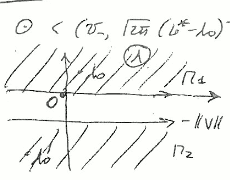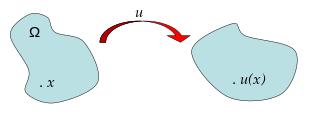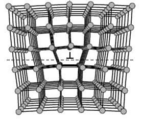Research
Analysis of PDEs

Calculus of Variations
Control Theory
Dynamical Systems
Harmonic Analysis
Multi-Scale Analysis and Scale Bridging
Operator Theory and Applications

Analysis of PDEs
Existence, Regularity, and Blow-up of Solutions for Elliptic and Parabolic Equations
Research staff: Victor Galaktionov, Roger Moser, Monica Musso, Hartmut SchwetlickModern methods to construct solutions of PDEs generally depend to a high degree on abstract functional analysis and produce generalised solutions in the first instance. Often one can then prove that these solutions are in fact smooth and solve the PDE in the classical sense, but for nonlinear problems in particular, it is also possible that they form singularities, often referred to as blow-up for time-dependent problems.
Problems studied in the department include second and higher order PDEs coming from a range of backgrounds such as combustion, mathematical biology, fluid mechanics, nonlinear optics, liquid crystals, elasticity, or differential geometry.
Nonlocal PDEs
Research staff: Monica Musso, Johannes ZimmerNonlocal energies arise naturally as the continuum limit of discrete, pairwise interactions, as the number of particles becomes increasingly large. The nature and size of the particles can be very different, ranging from atoms, molecules, droplets, charges, defects, to insects, birds, people, cars. The variety of the systems that can be broadly thought of as particle systems makes this field very relevant across disciplines - in particular in materials science and in biology.
Nonlocal PDEs are successfully used to model aggregation phenomena. The interaction potential, which is typically repulsive at short distance and attractive at large distance, describes the tendency of individuals to stick together in groups, but not too closely to each other. The analysis of equilibrium states and evolutions driven by nonlocal energies is a challenging and very active field in mathematics. It requires the combination of techniques and tools from harmonic analysis and potential theory, gradient flows, calculus of variations, and offers natural connections with large deviations and probability theory.
Pseudo-Differential Operators
Research staff: Veronique FischerA pseudo-differential operator is an extension of the concept of differential operator. Its definition relies on the Fourier transform. The theory of pseudo-differential operators emerged in the mid 1960s from the the study of singular integral operators in harmonic analysis. It began with the work of Kohn, Nirenberg, Hörmander, Unterberger and Bokobza and played an influential role in the first proof of the Atiyah–Singer index theorem.
Pseudo-differential operators are used extensively in the analysis of partial differential equations and quantum field theory.
Semiclassical Analysis of Wave Propagation Problems
Research staff: Euan SpenceIn the context of wave problems involving acoustic and electromagnetic waves, semiclassical analysis seeks to understand the behaviour of the waves in the difficult high-frequency limit, and also to investigate related questions about resonances and propagation of singularities.
Our particular interest is in working at the interface between semiclassical analysis (SCA) and numerical analysis (NA) of wave propagation problems. Our goals are to
- prove results in the SCA of wave propagation motivated by NA and applications, and
- use these results, along with other tools and results in SCA, to prove results in NA about wave propagation.
Calculus of Variations
Asymptotic Analysis of Variational Problems
Research staff: Kirill Cherednichenko, Roger Moser,
When a problem depends on a parameter that typically takes very small (or very large)
values, then some insight can often be gained by studying the asymptotic behaviour
as the parameter tends to 0 (or ∞). For variational problems, one of the most
successful tools for this purpose is Γ-convergence, which often allows to identify
an effective
(limiting) variational problem that captures the essential features
of the underlying system.
Examples where such an approach works include the following.
- Problems in elasticity are often formulated in terms of variational problems. If an elastic body is made from a composite material (for example with soft inclusions in a stiff matrix), or is thin in at least one dimension (a rod, plate, or shell), then we may regard the typical length scale of any inclusions or the thickness as a small parameter, as well as the ratio between the elastic moduli in the inclusion and in the matrix.
- Crystal defects such as dislocations exist on an atomic scale but have medium- to large-scale effects. An asymptotic analysis can help to develop a continuum model in the many-particle limit that accounts for these effects.
- On the other hand, starting from a continuum model for systems such as liquid crystals or ferromagnets that exhibit geometric patterns, we may bring out the topological nature of these patterns in a limiting model with topological singularities.
Geometric Variational Problems
Research staff: Roger Moser, Hartmut SchwetlickIn differential geometry, the most interesting objects often satisfy variational principles and are described by differential equations. For example, on a Riemannian manifold, the shortest connection between two points is a geodesic and satisfies a certain ODE. Typically, the equations obtained from such problems are nonlinear PDEs due to the curvature of the underlying spaces, often with critical or supercritical nonlinearities that are difficult to control with analytic methods alone. But when combined with geometric insight, the tools from the theory of PDEs can provide powerful new methods, sometimes with applications outside of differential geometry as well.
At Bath, research in geometric analysis concentrates on elliptic and parabolic problems. The problems studied include harmonic and biharmonic maps, curvature flows, and equations from conformal geometry.
Rearrangement of Functions and Vortices in Fluids
Research staff: Geoffrey BurtonThe notion of a rearrangement of a function (another function whose super-level sets have the same measure as those of the original function) has long been important in classical analysis, playing a key role in geometric inequalities. Recently the study of the set of all rearrangements of a given function has received attention. The geometry of such sets is of intrinsic interest, but it also plays a role in understanding certain problems in hydrodynamics, where the vorticity evolves as a rearrangement of its initial state. Methods of functional analysis, especially convex analysis and minimax theory, have been applied to prove existence and multiplicity theorems for the solutions of some variational problems, introduced by V.I. Arnolʹd and T.B. Benjamin, where the constraint is the set of rearrangements of some pre-assigned function. Such solutions represent steady vortices and this viewpoint illuminates questions of stability.
Rearrangement of vector-valued functions is another topic of recent interest due to its connection with Optimal Transport and here there are some surprising differences from the scalar-valued case.
Variational Principles in Continuum Mechanics
Research staff: Roger Moser, Jey Sivaloganathan, Johannes Zimmer
Variational principles are ubiquitous in mechanics. In the context of a continuum theory for a solid or fluid, they typically give rise to partial differential equations, for example in the form of Euler-Lagrange equations. These equations may be challenging on their own, but often they need to be studied in conjunction with constraints or selection criteria, coming from the physical context, which give rise to additional difficulties or additional structure.
Our interests include (but are not limited to) variational problems in elasticity, fracture and damage theories, liquid crystals, micromagnetics, and plasticity.
Variational problems in L∞
Research staff: Roger MoserThe calculus of variations deals with the problem of maximising or minimising certain quantities. Most of the known methods are designed for quantities given in terms of the integral of a function. When working with variational problems in L∞, we try to minimise the maximum of a function instead.
While there is a well-developed theory for some problems of this sort, not much is known for variational problems in L∞ that involve vector-valued functions or derivatives of second or higher order. We aim to develop new tools for the study of these problems.
Control Theory
Control of Positive Systems including Applications to Mathematical Biology
Research staff: Chris Guiver, Hartmut LogemannPositive dynamical systems, or simply positive systems, are dynamical systems where the evolution map leaves a positive cone invariant, such as the nonnegative orthant of Euclidean space, equipped with the partial order of component wise inequality. The study of positive systems is motivated by numerous applications across a diverse range of scientific and engineering contexts where invariance of a positive cone capture the essential property that state-variables of positive systems must take nonnegative values to be meaningful. The breadth and depth of applications of positive and (related) monotone systems has generated significant interest in their control. Our research focusses on:
- stability of nonlinear positive dynamical systems – both forced and unforced;
- the relaxation of classical positive input control systems to the special case where negative controls are permitted, provided that nonnegativity of the state is not violated, and;
- applications of 1. and 2. to problems and societal challenges arising in biology and ecology, such as dynamic resource management (crop pests and pest pathogens, for example).
Infinite-Dimensional Control Systems
Research staff: Chris Guiver, Hartmut Logemann, Mark OpmeerThe control of infinite-dimensional, or so-called distributed-parameter, systems, such as dynamical systems specified by controlled and observed partial or delay differential equations is motivated by:
- their prevalence in applications, and;
- the mathematical challenges caused by infinite-dimensionality.
Of particular interest to our research group is the development of aspects of the other listed research areas (for example: model reduction, nonlinear control systems and input-to-state stability) in infinite-dimensional settings.
Model Reduction
Research staff: Chris Guiver, Mark OpmeerIt is often desirable to replace an accurate but complex model for a physical biological or engineering system by a perhaps slightly less accurate but simpler model. The process to extract the simpler model from the more complex one is called model reduction. Our research on model reduction mainly focuses on two cases:
- the case where the original complex model is given by partial differential equations;
- the case where the original model has a structure (such as positivity or passivity) which must be retained in the simpler model.
Nonlinear Control Systems and Input-to-State Stability
Research staff: Chris Guiver, Hartmut LogemannThe concept of input-to-state stability (ISS) relates to stability properties of forced nonlinear systems (the forcing is frequently called input). Since its inception in 1989, this concept has generated a rich body of results, in particular, extending classical Lyapunov theory to systems with inputs. Our work in this area focuses on the following aspects:
- ISS and classical absolute stability theory;
- ISS in an infinite-dimensional context with applications to controlled PDEs and FDEs;
- ISS in the context of differential inclusions which allows applications to systems with discontinuous nonlinearities (such as Coulomb friction and quantization);
- ISS results for hysteretic feedback systems;
- ISS methods in the context of population dynamics.
Sampled Data Feedback Systems
Research staff: Hartmut LogemannA sampled-data feedback system consists of a continuous-time system a discrete-time controller and certain continuous-to-discrete (sample) and discrete-to-continuous (hold) operations. Sampled-data control theory forms the mathematical foundation of digital control which addresses the problem of implementing control strategies using digital computers. Our activities focus on:
- sampled-data integral controllers for linear infinite-dimensional systems subject to input and output nonlinearities (possibly of hysteresis type);
- dynamic low-gain finite-dimensional sampled-data controllers for stable linear infinite-dimensional systems, achieving approximate asymptotic tracking and disturbance rejection;
- indirect sampled-data stabilization of linear infinite-dimensional systems (that is, sampled-data stabilization via discretization of a stabilizing continuous-time controller using suitable sample-and-hold operations);
- dynamic finite-dimensional sampled-data stabilization of linear infinite-dimensional systems with finite-dimensional unstable dynamics.
Dynamical Systems
Pattern Formation and Infinite-dimensional Dynamical Systems
Research staff: Karsten Matthies, Hartmut Schwetlick, Johannes Zimmer
Pattern formation is the study of the spontaneous appearance of coherent spatial structure, often with a characteristic wavelength, in externally driven, nonlinear PDEs and spatially discrete coupled systems, which all have Infinite-dimensional phase space. One important example are travelling waves in lattice dynamical systems. A variety of tools from the calculus of variations, PDEs and Dynamical Systems Theory can be applied, such as mountain pass arguments, compensated compactness or spatial dynamics. One challenge is to prove the existence of waves for a number of lattice dynamical systems; another challenge is to prove qualitative statements, such as stability.
Harmonic Analysis
Research staff: Veronique FischerHarmonic analysis is the modern generalisation of Fourier’s work on trigonometric series. The aim is to understand decompositions of functions in order to analyse partial differential equations. It is naturally linked with decomposition of functional spaces, operators, and (measurable) spaces, thereby encompassing large parts of integration and operator theory as well as functional analysis.
An important part of harmonic analysis concerns settings with structures naturally providing functional decompositions and operators. For instance, representation theory of Lie groups yields decompositions of functions and invariant operators.
Multi-Scale Analysis and Scale Bridging
Homogenisation and Asymptotic Analysis
Research staff: Kirill Cherednichenko, Karsten Matthies
The mathematical theory of homogenisation is a branch of analysis that has been in active development
since the late 1960s, motivated by the need for analytical tools for qualitative and quantitative
analysis of continuous media with multiple length-scales and by the problem of scale bridging
,
i.e. understanding how specific geometric arrangements and interaction rules at a small scale result
in certain kinds of material response at a large scale, i.e. when the number of microscopic
constituents is large. Due to the presence of a natural parameter (or parameters) in such multi-scale contexts,
namely the ratio of the two (or more) length-scales, it is convenient to study the related problems
using tools of asymptotic analysis, such as asymptotic expansions, multi-scale versions of the classical
convergence and compactness techniques in Sobolev spaces, Gamma convergence etc. This toolbox is a part
of what is often referred to as multi-scale analysis and is aimed at providing an effective
description
for the original multi-scale medium, where the detailed information at the level of miscrostructure
is replaced by a simpler, yet physically equivalent, formulation.
Discrete-to-continuum Upscaling
Research staff: Karsten Matthies, Johannes Zimmer
Discrete systems with many degrees of freedom occur when physical systems are resolved up to the atomic level. Particles then form lattices or gases. Many physical problems are well described on a microscopic scale by atoms which are linked by nonlinear springs. Such models appear in solid state physics (e.g., in models for the elastic and plastic behaviour of crystals). The governing equations are so-called lattice dynamical systems. Recent research studies the connection and differences of such discrete systems and the corresponding continuum descriptions via partial differential equations. For particle gases the research aims to explain how equations on different scales can have fundamentally different behaviour by providing rigorous convergence results for the correct scaling in the many particle limit. A fundamental question is to derive (continuum, irreversible) Boltzmann equations from (atomistic, reversible) Newtonian mechanics.
Operator Theory and Applications
Applications in Systems and Control
Research staff: Chris Guiver, Hartmut Logemann, Mark OpmeerMany aspects of operator theory play a role in systems and control. Our work includes the application of and the further development of operator theory related to:
- semigroups of linear operators;
- Hankel operators;
- operator-valued holomorphic functions;
- optimization in Hilbert spaces;
- positive operators;
- operator Lyapunov and Riccati equations;
- dissipative operators in both definite and indefinite inner-product spaces.
Applications to Problems in Materials Science
Research staff: Kirill Cherednichenko
Methods of functional analysis and abstract operator theory, motivated initially
by the development of a mathematical framework for quantum mechanics, provide powerful
tools in understanding the behaviour of existing materials and in predicting the material
response of new composite media obtained by combining known materials according to specific
geometric rules. A wide class of systems
, i.e. a combination of basic material components
arranged together in a prescribed way, can be described by means of a suitable extension
of a minimal
operator defined on a space of smooth functions. Quantitative characteristics
of such an extension are expressed in terms of a suitable version of the
Dirichlet-to-Neumann map, namely the so-called Weyl-Titchmarsh M-function, for the
corresponding maximal
operator. These are often amenable to asymptotic analysis with
respect to the size of the microstructure, which yields new asymptotically equivalent
models in the contexts of diffusion, elasticity, electromagnetism etc., shedding light
on the behaviour of the original complex system.
Wave Scattering
Research staff: Kirill Cherednichenko
The development of spectral theory of operators has been closely linked to the needs
of scattering theory, especially in the context of quantum-mechanical scattering.
Using as a starting point the interpretation of a system
, e.g. a composite medium,
in operator-theoretic terms, allows one to obtain a new point of view on problems of
wave propagation in the context of materials science. In particular, the formulation of a
functional model for the corresponding operator allows one to readily obtain formulae
for the associated scattering matrix, which describes the interaction of the composite
medium with wave packets emitted by a remote source in the free space. This kind of
formulae are relevant to the analysis of real-world measurements, e.g. tomography, and
at the same time provide a new language for effective medium
theories for media with multiple length-scales.